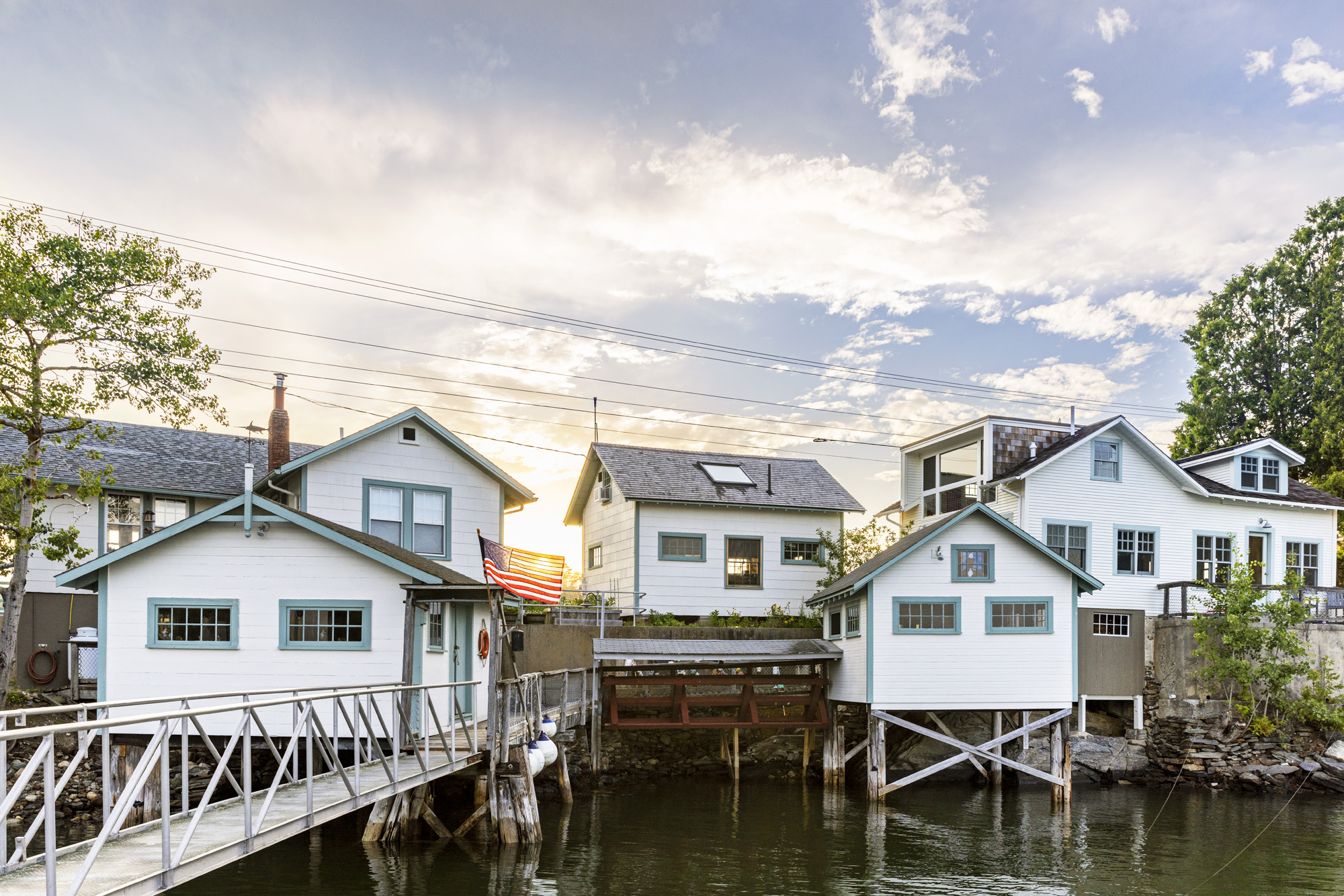Common characteristics of a home include a single structure, personal belongings, decor, art, and perhaps a garage. Uncommon characteristics? Eleven buildings—comprised of dwellings and bait sheds—a working waterfront, loading ramps, and a floorboard in the attic that reads Royal Gurnet Lobster House.

These uncommon features are all part of one unique property on the coast of Brunswick. When Lili Liu and Blake Civiello first saw this home in 2018, they instantly fell in love. Though the property—home to eleven aging buildings, only two of which were habitable—might have driven most people away, Lili and Blake had the opposite reaction. Blake, an architect, immediately saw the potential in the historic site, which was once owned by the Coffin family. Under the Coffins’ stewardship, the property was run as a lobstering compound. Soon, it was theirs. In 2020, they moved to Brunswick full-time.

Inspired by the site’s history, Lili and Blake decided to make the property’s working waterfront status official. Lili says, “We codified it with the town to secure its status. There’s only one other property in Brunswick with that designation.” As they built relationships with local oyster farmers and lobstermen, they realized how crucial it was to provide access to the working waterfront, with only twenty miles remaining in Maine. “The definition of ‘working waterfront’ varies from town to town,” says Lili. “Luckily, Blake was able to justify and design a plan to prove to the town how the property would be used commercially.”


Owning this historic property has proved to have many advantages in addition to the fulfillment they feel from supporting the local fishing community. Blake has a deep appreciation for a sense of place in his designs. Rather than following popular trends or relying on unimaginative plans, he embraces how climate, history, and culture influence architecture in a particular region. Here, on the rugged coast of Maine, the eleven buildings on their property represent the history of lobstering. Inherited antiques from the previous owners—old lobster traps, signs, and buoys—bring the interiors to life.

To honor the legacy of the home, the couple made minimal changes. Instead of altering cosmetic details, they only touched what needed fixing, like the plumbing and insulation in their main house. For Lili, she finds it special to have a daily reminder that someone lived here previously. The original windows of the main house didn’t face the ocean, which a non-lobsterman may find off-putting. “The owners worked out on the water all day and didn’t want to look at it when they came home,” Lili laughs. She imagines the grueling hours spent on the ocean, with the smell of seafood and the creaking of ships. “You develop a different concept of ‘home’ when you work outside versus inside,” she reflects.


Another surprising find was an old sign reading Royal Gurnet Lobster House, used as a floorboard in the attic. The Coffin family told Lili and Blake that the sign had been there for decades. “We found postcards showing the property when it was a ferry landing,” Lili shares. She’s also unearthed old photographs of their main house dating back to the 1860s—small pieces of the puzzle that reveal the home’s layered past.

The Coffins only used the property during the summer months, so many of the buildings—like the summer kitchen—were never insulated. This is Lili’s favorite part of the home. The kitchen preserves its rustic charm with exposed wooden walls and minimalistic countertops. With windows that look out over the ocean (unlike the main house), it serves as a scenic spot for the couple to entertain friends and family during the warmer months. This has been the site of many slow, joyful meals. Cooking and eating are central to the couple’s life, and this kitchen is a place where they feel at home.

One unexpected boon when purchasing this house was the connection to Maine and community. “So many people in the area have some tie to our property, whether they use it commercially or have memories of the buildings. We had an oyster farm day and open house, and so many neighbors stopped by to share their stories,” says Lili. Originally from L.A., she is in awe of the ‘Yankee spirit.’ “People here have a very can-do attitude,” she notes. “Our neighbors, who are in their 70s, still change out their boilers by themselves. There’s a saying around here, ‘There’s no bad weather, just bad clothes.’ The people are tough and resourceful.”
Good news for readers: Lili and Blake have converted one of the eleven buildings into an Airbnb for guests who want to experience the magic of their historic coastal retreat. Step inside—literally—this historic property for yourself.





